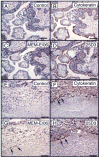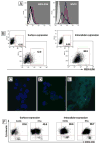Non-classical MHC-E (Mamu-E) expression in the rhesus monkey placenta
- PMID: 17996936
- PMCID: PMC2754872
- DOI: 10.1016/j.placenta.2007.10.001
Non-classical MHC-E (Mamu-E) expression in the rhesus monkey placenta
Abstract
The aim of this study was to characterize the expression of the rhesus HLA-E ortholog Mamu-E, particularly at the maternal-fetal interface. Mamu-E expression was confirmed by locus-specific RT-PCR in the placenta as well as in peripheral blood mononuclear cells (PBMC) and other organs. We evaluated the utility of antibodies recognizing HLA-E (MEM-E/06 against native HLA-E, MEM-E/02 against denatured HLA-E) to detect Mamu-E by flow cytometry/immunofluorescence, Western blot, and immunohistochemistry (IHC). Western blot analysis of cells and selected transfectants confirmed the recognition of Mamu-E but not Mamu-AG by antibodies MEM-E/06 and HC10 but not MEM-E/02. Immunohistochemical staining of frozen sections of rhesus placenta with the MEM-E/06 antibody demonstrated expression in most populations of rhesus monkey trophoblast cells, including villous cytotrophoblasts (strong positive staining), apical membrane of syncytiotrophoblasts (light to moderate staining) and extravillous cytotrophoblasts (moderate to strong staining, especially endovascular trophoblasts in early pregnancy). Expression was not trophoblast cell-specific, especially at term, when endothelial cells in both the chorionic plate and placental villi showed strong staining for Mamu-E. Staining of rhesus extravillous trophoblast cells suggested the co-expression of Mamu-E and Mamu-AG (the rhesus HLA-G homolog) on these cells. MEM-E/06 was shown also to react with differentiating rhesus placental syncytiotrophoblasts in primary culture, detecting intracellular and weak surface expression of Mamu-E. We conclude that the gestation-dependent co-expression of Mamu-E with Mamu-AG in villous and extravillous trophoblast cells suggests important and perhaps complementary but distinct roles of these two non-classical MHC class I loci in pregnancy at the maternal-fetal interface. In addition, the MEM-E/06 antibody will be useful for the detection of Mamu-E at the maternal-fetal interface in the rhesus monkey.
Figures
Similar articles
-
The rhesus monkey analogue of human lymphocyte antigen-G is expressed primarily in villous syncytiotrophoblasts.Biol Reprod. 1998 Mar;58(3):728-38. doi: 10.1095/biolreprod58.3.728. Biol Reprod. 1998. PMID: 9510960
-
A soluble isoform of the rhesus monkey nonclassical MHC class I molecule Mamu-AG is expressed in the placenta and the testis.J Immunol. 2002 Jul 15;169(2):673-83. doi: 10.4049/jimmunol.169.2.673. J Immunol. 2002. PMID: 12097369
-
Placental expression of the nonclassical MHC class I molecule Mamu-AG at implantation in the rhesus monkey.Proc Natl Acad Sci U S A. 2000 Aug 1;97(16):9104-9. doi: 10.1073/pnas.97.16.9104. Proc Natl Acad Sci U S A. 2000. PMID: 10922066 Free PMC article.
-
HLA class I expression on the materno-fetal interface.Am J Reprod Immunol. 1997 Sep;38(3):150-7. doi: 10.1111/j.1600-0897.1997.tb00291.x. Am J Reprod Immunol. 1997. PMID: 9325485 Review.
-
Placental HLA-G protein expression in vivo: where and what for?Hum Reprod Update. 1999 May-Jun;5(3):223-33. doi: 10.1093/humupd/5.3.223. Hum Reprod Update. 1999. PMID: 10438107 Review.
Cited by
-
The Role of MHC-E in T Cell Immunity Is Conserved among Humans, Rhesus Macaques, and Cynomolgus Macaques.J Immunol. 2018 Jan 1;200(1):49-60. doi: 10.4049/jimmunol.1700841. Epub 2017 Nov 17. J Immunol. 2018. PMID: 29150562 Free PMC article.
-
On the role of placental Major Histocompatibility Complex and decidual leukocytes in implantation and pregnancy success using non-human primate models.Int J Dev Biol. 2010;54(2-3):431-43. doi: 10.1387/ijdb.082797tg. Int J Dev Biol. 2010. PMID: 19876826 Free PMC article. Review.
-
In vitro differentiation of macaque extravillous trophoblasts in a low oxygen environment.Placenta. 2025 Apr;163:16-28. doi: 10.1016/j.placenta.2025.02.014. Epub 2025 Feb 25. Placenta. 2025. PMID: 40024139
-
HLA-E: exploiting pathogen-host interactions for vaccine development.Clin Exp Immunol. 2019 May;196(2):167-177. doi: 10.1111/cei.13292. Epub 2019 Apr 9. Clin Exp Immunol. 2019. PMID: 30968409 Free PMC article. Review.
-
Placenta-derived macaque trophoblast stem cells: differentiation to syncytiotrophoblasts and extravillous trophoblasts reveals phenotypic reprogramming.Sci Rep. 2020 Nov 5;10(1):19159. doi: 10.1038/s41598-020-76313-w. Sci Rep. 2020. PMID: 33154556 Free PMC article.
References
-
- Moreau P, Dausset J, Carosella ED, Rouas-Freiss N. Viewpoint on the functionality of the human leukocyte antigen-G null allele at the fetal-maternal interface. Biol Reprod. 2002;67:1375–1378. - PubMed
-
- Ishitani A, Sageshima N, Lee N, Dorofeeva N, Hatake K, Marquardt H, Geraghty DE. Protein expression and peptide binding suggest unique and interacting functional roles for HLA-E, F, and G in maternal-placental immune recognition. J Immunol. 2003;171:1376–1384. - PubMed
-
- Kovats S, Main EK, Librach CL, Stubblenbine M, Fisher SJ, DeMars R. A class I antigen, HLA-G, expressed in human trophoblasts. Science. 1990;248:220–223. - PubMed
-
- Hunt JS, Petroff MG, Morales P, Sedlmayr P, Geraghty DE, Ober C. HLA-G in reproduction: studies on the maternal-fetal interface. Hum Immunol. 2000;61:1113–1117. - PubMed
Publication types
MeSH terms
Substances
Grants and funding
LinkOut - more resources
Full Text Sources
Research Materials







